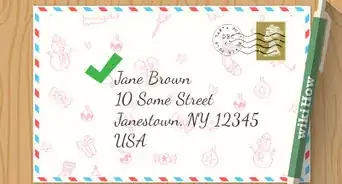This article was co-authored by wikiHow staff writer, Christopher M. Osborne, PhD. Christopher Osborne has been a wikiHow Content Creator since 2015. He is also a historian who holds a PhD from The University of Notre Dame and has taught at universities in and around Pittsburgh, PA. His scholarly publications and presentations focus on his research interests in early American history, but Chris also enjoys the challenges and rewards of writing wikiHow articles on a wide range of subjects.
There are 7 references cited in this article, which can be found at the bottom of the page.
This article has been viewed 13,149 times.
Learn more...
When you picture Santa, you almost certainly imagine him having a deep, booming, jovial voice that is punctuated with a trademark "ho ho ho!" There are ways you can try to mimic the Santa voice you have heard on television, but being a convincing Santa is at least as much about the attitude you bring to your voice. Focus on sounding, appearing, and acting kind, approachable, merry, and wise—and practice your belly laugh while you are at it.
Steps
Talking Like Santa
-
1“Santa-fy” your own voice instead of copying someone else's. If you get too caught up trying to sound like a specific Santa, like one from a film, television show, or department store, your voice will end up sounding really fake. Instead, focus more on giving your own voice a Santa-rific spin! The children and adults you meet will remember your jolly attitude way more than the specifics of your voice.[1]
- Who says Santa cannot sound just like you? If you leave everyone smiling and full of holiday spirit, you will know you have done your job.
- Listen to other Santa voices not so much to copy their sound, but to get inspiration for your own Santa voice.
-
2Deepen your voice a little without going overboard. If you want to do a "classic Santa" that does not sound exactly like you, aim to make your normal voice just sound a little deeper. Practice putting your hand on your belly and exhaling from your diaphragm while you speak. Do not go so deep that you cannot speak with a smile, though![2]
- When you deepen your voice, there can be a fine line between sounding like "jovial Santa" as opposed to "grumpy Santa" or even "creepy Santa." Always remember that the attitude you present with your voice is what counts.
Advertisement -
3Practice saying things you are likely to say as Santa. While you can never be sure what types of conversations you will have as Santa, there are some questions, answers, and comments that you can expect to use. Master several of these first, then practice speaking on random topics with your Santa voice. Common Santa sayings might include:[3]
- “What's your name, little one?”
- “What would you like for Christmas, Jane?”
- “Yes, Rudolph has been a very good reindeer this year!”
- “I did get the letter you sent me. Can you remind me what you asked for?”
- “No, I didn't put your brother on the naughty list this year. But it was close!”
-
4Come up with easy questions that will put nervous kids at ease. You cannot predict how kids will respond to Santa. When a child is apprehensive, you will have to dial back on the boisterousness of your joy, but maintain a happy and caring attitude. Practice asking a few simple questions to get a nervous child talking. For example:[4]
- “What kind of treats do you think I should give my reindeer this year?”
- “Do you think it is snowing back home at the North Pole?”
- “Have you been working on your Christmas list?”
- “What is your favorite holiday song?”
-
5Practice answering silly and difficult questions appropriately. While some children clam up around Santa, others are full of questions. They might ask you how you get all around the world in one night, how you fit all the presents in your sleigh, or even if you are the “real” Santa! Come up with consistent answers beforehand that fit your Santa persona—you might focus on your “Santa magic,” for instance, or how the Earth's rotation gives you extra night-time to work with.[5]
- Kids may also ask difficult or uncomfortable questions. They may ask why you did not bring them the toy they really wanted last year, or even if you can bring back a loved one who passed away during the year. In these cases, you may want to work on tactful ways to let them know that Santa's magic does have its limits.
-
6Check your facial expressions by practicing your voice in the mirror. Practicing before your Santa debut is always helpful, but practicing with a mirror shows you if you have a joyful appearance while doing your Santa voice. If you can’t look jolly while speaking as Saint Nick, make adjustments until you can.[6]
- This may seem less important if you are just planning on calling someone as Santa. In reality, though, genuinely smiling and being happy while you talk makes your voice sound more joyful, even if the other person cannot see you!
-
7Use a “Santa voice” app to leave someone a message from Kris Kringle. If you are looking to make a call or leave a message as Santa and just are not satisfied with your own Santa voice, there are apps that can help. Search your preferred app store for “Santa voice” and check out your options. While some apps have another person read your chosen message in a Santa voice, others let you modulate the sound of your own recorded voice to make it more Santa-like.
- This is a good option if you want Santa to call your kids, but are worried they’ll recognize your slightly “Santa-fied” voice. You can tinker with the app until the voice sounds practically nothing like yours.
- Make sure you choose a legitimate app that has the seal of approval from your app store and lots of good user reviews.
Mastering a Santa Laugh
-
1Laugh out your “ho, ho, ho” instead of speaking it. “Ho, ho, ho” isn’t supposed to be Santa’s catchphrase—it’s supposed to be the closest approximation of what his laugh sounds like! So, do not practice saying the phrase in a jovial way. Instead, practice shaping your laugh so it makes this classic sound.[7]
- It may help to listen to yourself laugh naturally. Consider recording yourself watching one of your favorite funny videos, shows, or movies. Work on how to combine your natural laugh with the “ho, ho, ho” sound.
-
2Place your hand on your belly to focus on your diaphragm. While “ho, ho, ho” is indeed a laugh, doing a simple singing exercise can help you bring your version of Santa’s iconic chuckle to the surface. Stand with your hand placed right over your belly button and your fingers spread out. Pay attention to what you feel once you start practicing your Santa sounds.[8]
- Don’t push in forcefully. Apply mild to moderate pressure instead.
-
3Feel your belly draw in each time you make a “ho” sound. When it’s time to practice making your Santa laugh, feel it coming from deep inside your belly. Make your “ho ho ho” with a forceful puff of air from your diaphragm. Your belly should pull in, not push out, with each “ho” sound you make.[9]
- Using your diaphragm creates a deeper, richer sound. They call it a “belly laugh” for a reason!
-
4Practice your facial expressions and body language in the mirror. Don’t strain so hard to laugh from deep in your belly that your Santa smile turns into a grimace. Dial back on the forcefulness of your belly laugh, if necessary, so that you can maintain a jolly expression. Your body should also stay relaxed—and if your belly jiggles a bit, all the better![10]
- Pay attention to your eyes while you do your Santa laugh, especially if you will be wearing a puffy white Santa beard. The beard will conceal much of your face, so it is up to your eyes to cue in the crowd that you’re jolly and joyful.
Warnings
- Skip the “Bad Santa” routine unless you’re sure it suits your audience. If you’re playing Santa at an adults-only party, it might be okay to act a bit flirtatious or tell some off-color jokes. But make sure you read the room! Lots of adults like to get the loving, kindly, jolly Santa experience instead of some naughty version.[12]⧼thumbs_response⧽
References
- ↑ https://youtu.be/cqyHLnVRiaE?t=55
- ↑ https://youtu.be/qHWst5nVbFo?t=50
- ↑ https://parade.com/242731/viannguyen/7-tips-on-playing-santa-from-the-dean-of-americas-foremost-santa-school/
- ↑ https://youtu.be/qHWst5nVbFo?t=90
- ↑ https://parade.com/242731/viannguyen/7-tips-on-playing-santa-from-the-dean-of-americas-foremost-santa-school/
- ↑ https://parade.com/242731/viannguyen/7-tips-on-playing-santa-from-the-dean-of-americas-foremost-santa-school/
- ↑ https://youtu.be/cqyHLnVRiaE?t=20
- ↑ https://takelessons.com/blog/2011/12/a-santa-approved-voice-exercise/
- ↑ https://takelessons.com/blog/2011/12/a-santa-approved-voice-exercise/




































































